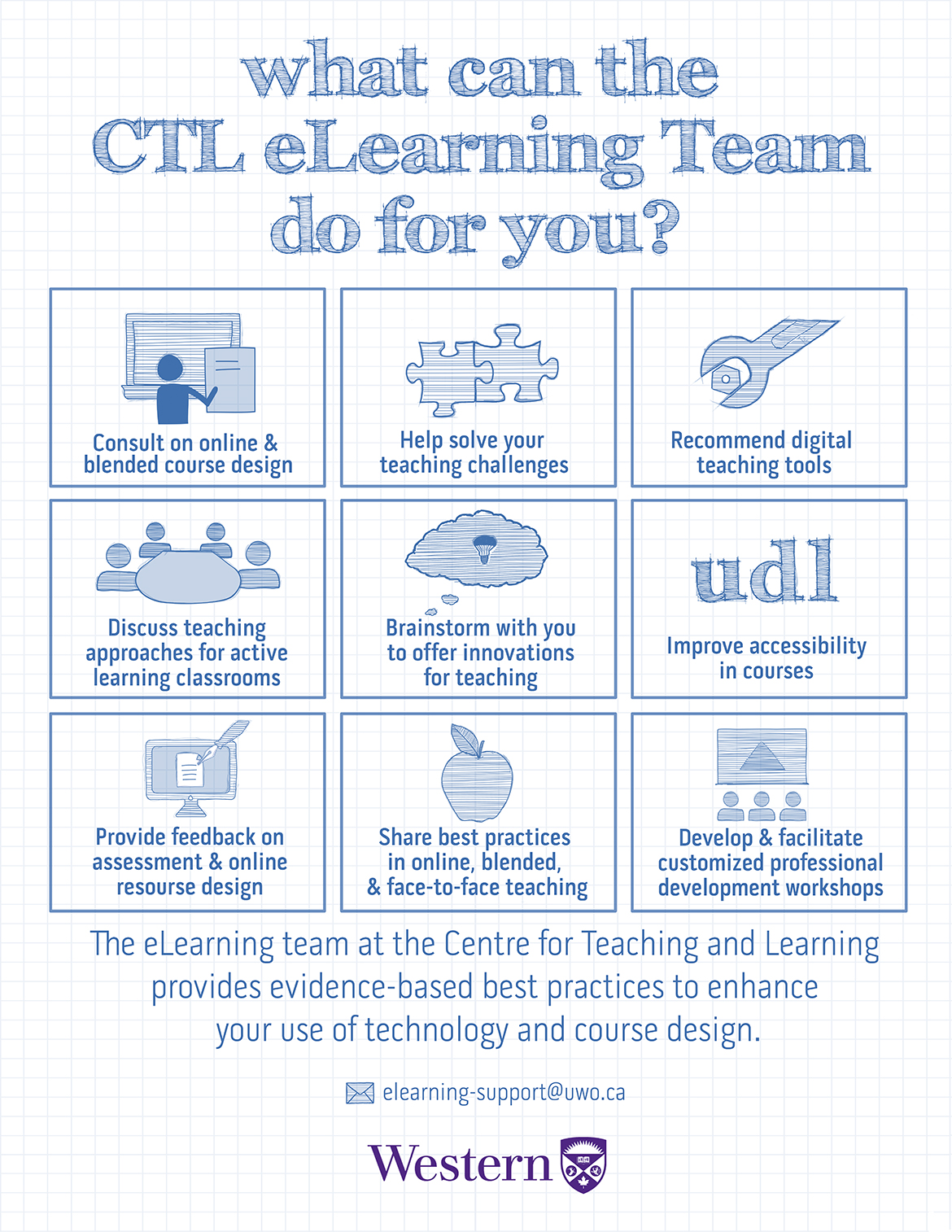Online Course Design
Western has a number of graduate and undergraduate students in the flexibility and self-directed learning opportunities provided by online courses. Online course offerings are clearly identified as section 650 courses in the academic calendar and lecture timetable. Designing a course for the online learning environment requires significant planning time and effort. Here are some some tips to help you make the most of your planning time.
planning Online Courses
To design your online course, begin with a backwards design approach. The backwards design approach works with any kind of course delivery method from fully online to face-to-face. It begins with writing course level learning outcomes. Next, choose or create assessments and teaching and learning activities that align with your outcomes. In this process you will answer the following questions:
- Learning Outcomes: What will students know, value, and be able to do by the end of the course?
- Assessment Methods: What assessment methods will provide evidence that students have achieved the learning outcome?
- Teaching and Learning Activities: What activities will students engage in as they progress towards the learning outcome?
Online course design requires some additional considerations:
- Teaching resources and materials: What teaching resources and materials will you need to select, develop, or adapt to support instruction?
- eLearning tools: What eLearning tools and techniques can you use (or ask the students to use) to help facilitate learning and allow students to demonstrate achievement of the learning outcomes?
We have created an eLearning course planning and alignment chart worksheet (.docx) to help you plan your online course using this approach. This process takes significant time before you launch your course or even build your course site, but saves you time in the long run. By using the backwards design approach, you will focus on the most important concepts and skils, and on ensuring that assessments, activities, tools, and resource choice support student learning. Starting with the big picture also allows you to identify a realistic initial offering of your course given your time constraints and resources.
Once you fill in this alignment chart worksheet, you may find that there are some components (e.g., assessments, lesson pages, videos, and modules) that require development. The final page of this worksheet provides space for you to start your development plan. Western Instructors might be interested in seeking the support of the Instructional Technology Resource Centre (ITRC) to help you put your development plan into action.
Designing Your Course Site
Once you have completed your high-level online course design, it is time to create a course schedule and develop the course components, including the OWL site itself.
It is particularly important to have a well-organized course site for an online course because students will be required to navigate your course structure on their own. Aim for what Harrison et al., (2018) calls a “Simple and Deep” design, where the course navigation is laid out clearly on the home page with an indication about how to move through course activities.
You will also want to give careful consideration to accessibility for your online course site and associated materials. You can investigate eLearning tool accessibility for many Western-supported and third-party tools at elearningtoolkit.uwo.ca
Further Reading and Worksheets
You can find more tips and best practices to improve your course site design using the following handout and checklist.
Facilitating an Online Course
Facilitating an online course requires careful consideration and, arguably, more planning up front than a face-to-face class. Literature on online learning suggests that building social presence (student-student interaction) and teaching presence (student-instructor interaction) are important for effective online learning (Garrison, 2009; Schwier, 2002). What will you, as an instructor, do throughout the course to facilitate student learning and ensure that your students are supported? What will you do each week to encourage students to learn from each other? Some questions you can consider regarding social presence and teaching presence in designing your course include:
|
Social presence |
Teaching presence |
|---|---|
|
|

This work, "What can eLearning at Western do for you?" is a derivative of "What can your instructional designer do for you?" by Jason Hogan, UPEI, used under 
Related programs:
Related resources:
Questions?
If you would like assistance on creating online courses, please contact the CTL eLearning team.
References
Garrison, D. R. (2009). Communities of inquiry in online learning. In P. Rogers, G. Berg, J. Boettcher, C. Howard, L. Justice, & K. Schenk (Eds.), Encyclopedia of Distance Learning, Second Edition (pp. 352-355). Hershey, PA: doi:10.4018/978-1-60566-198-8.ch052
Harrison, M., Irvine, A.K., Johnson, A., & Stein, J. (2015). Complexity and depth in LMS course design The Big Picture (infographic). Retrieved from https://www.canvaslms.com/downloads/HE-Infographic-Course-Design.pdf
Schwier, R.A. (2002). Shaping the metaphor of community in online environments. Paper presented to the International Symposium on Educational Conferencing. The Banff Centre, Banff, Alberta, 1-8. Retrieved from http://citeseerx.ist.psu.edu/viewdoc/download?doi=10.1.1.550.4715&rep=rep1&type=pdf
